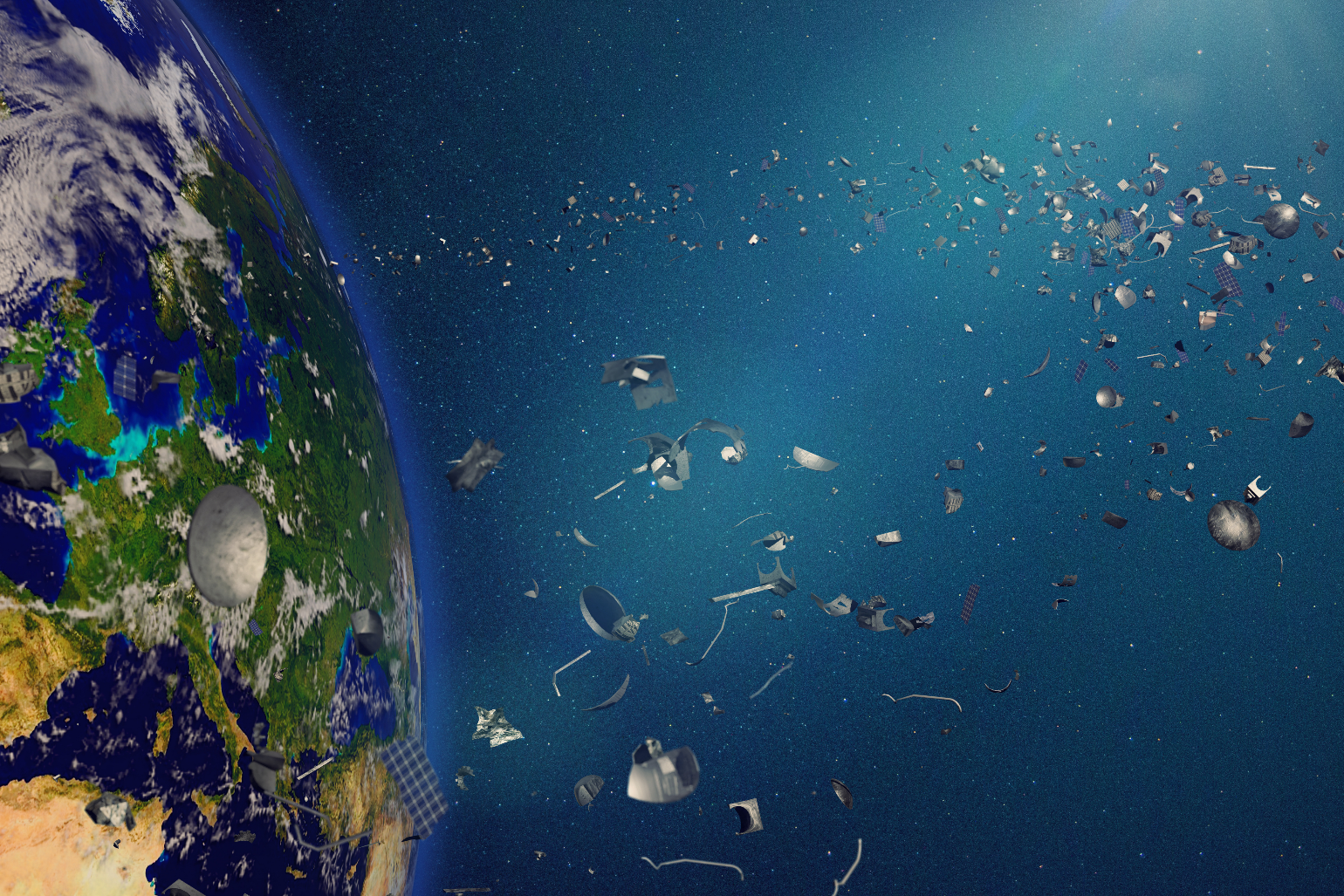Space Debris: A Worsening Problem
by Omkar Nikam
Strasbourg, France, January 15, 2021--Ever since satellites have been launched in outer space, both opportunities and risks have increased in the various earth orbits. For more than 50 years, more than 5000 rockets have been launched carrying multiple space objects, mainly satellites into orbit. Today most of these objects are either turned backed to earth or continue to revolve in earth orbits, ultimately increasing the risks for existing and future space infrastructure in low earth- (LEO), medium earth- (MEO), and geosynchronous earth (GEO) orbits.
According to the latest update on the space environment by the European Space Agency (ESA), more than 9100 tonnes of space debris are in several earth orbits. While the space agencies like ESA have initiated an action plan for space debris mitigation, the international cooperation is important to help keep our collective space environment safe and clean for future use of the outer space.
Understanding the Complex Landscape
 Currently, ESA is one of the agencies taking actionable steps towards reducing the space debris in the earth orbits. Similarly, we can observe that the emergence of the private space debris mitigation companies from the European region; ultimately signaling that Europe might be the future flagbearer of sustainable technologies in space. But to bring together several other agencies and companies to make such an investment in the removal of space debris, there should be an international dialogue presenting opportunities, growth, and sustainable future. Dr. Moriba Jah, an associate professor of Aerospace Engineering and Engineering Mechanics at the University of Texas at Austin, mentioned in one of the recent webinars that “We need to develop a space domain digital twin to understand this complex system as it will help us gain more knowledge about the decision-making criteria.” As per the Dr. Jah’s statement, it is very important for the government and private entities to fully understand the nature of space debirs and how it will be affecting our future in utilizing earth orbits.
Currently, ESA is one of the agencies taking actionable steps towards reducing the space debris in the earth orbits. Similarly, we can observe that the emergence of the private space debris mitigation companies from the European region; ultimately signaling that Europe might be the future flagbearer of sustainable technologies in space. But to bring together several other agencies and companies to make such an investment in the removal of space debris, there should be an international dialogue presenting opportunities, growth, and sustainable future. Dr. Moriba Jah, an associate professor of Aerospace Engineering and Engineering Mechanics at the University of Texas at Austin, mentioned in one of the recent webinars that “We need to develop a space domain digital twin to understand this complex system as it will help us gain more knowledge about the decision-making criteria.” As per the Dr. Jah’s statement, it is very important for the government and private entities to fully understand the nature of space debirs and how it will be affecting our future in utilizing earth orbits.
Opportunities & Risks
Taking a note of fast track innovation in the space engineering segments, companies like ClearSpace, a Switzerland based startup, are brining some of the best-known approaches for the removal of space debris. On the other hand, OrbitFab, a California based in-orbit space product and services startup, will be setting a mark for reducing the launch of new satellites by refueling/replacing parts of the existing systems in-orbit. There is definitely a growth and simultaneously an opportunity to innovate in the space debris mitigation vertical. But currently as there is no real-time deployment of fully functioning space debris removal spacecraft, the future remains uncertain.
According to ESA, “34000 objects greater than 10 cm, 900000 objects from greater than 1 cm to 10 cm, and 128 million objects from greater than 1 mm to 1 cm” are currently in orbit and are a potential threat to both the International Space Station (ISS) and the satellites in LEO, MEO, and GEO. Currently the most threat of space debris is for the objects in LEO. Several satellite operators like Starlink by SpaceX, Telesat, Kuiper by Amazon, etc. are now targeting LEO for operating a constellation of thousands of satellites. This has eventually increased the risk of space debris for existing human infrastructures in space like ISS. According to the Kessler Syndrome, a term proposed by NASA scientist Donald J. Kessler in 1978, provides a theoretical scenario that “The density of objects in LEO due to space pollution is high enough that collisions between objects could cause a cascade in which each collision generates space debris that increases the likelihood of further collisions.” Therefore, deploying a hardware system to remove the space debris, especially in LEO is risky as per the Kessler Syndrome.
Space Situational Awareness and International Cooperation
As far as the sustainable measures are concerned, we as the human race to have join hands together to keep our earth orbits safe and secure for the future generations. ESA’s Space Situational Awareness (SSA) is a programme which considers Space Weather, Near-earth Objects (NEO), and Space Survelliance and Tracking (SST), has gained momentum in the recent years, mainly due the rising issues related to space debris. Though a first step, ESA has made an investment of approximately USD 102 million (given as a contract to a Swiss startup, ClearSpace). With these strategic steps, ESA is currently marching towards a sustainable future in space by not only mitigating the space debris, but also accommodating and encouraging private players in this arena.
Similarly, the other government space agencies need to take a step to realize what are the possible growth and opportunity indicators for stepping into the zone of space debris mitigation. In the past we have seen several satellite collisions between different countries, which has eventually led to the increase in the space pollution. Therefore, encouraging and joining hands together to make space as a safe and secure place is the need of the time for this generation. On the other hand, companies OKAPI: Orbits, a startup based in Braunschweig, Germany, has already initiated an AI-driven SSA platform to help the satellite operators better understand the space debris situation around their respective in-orbit space systems. The similar innovate private players should be encouraged by the governments to accelerate the space debris mitigation plans. And this will eventually help the global space agencies and institutions/organizations to map the landscape of the sustainable earth orbits.
Conclusion
The space pollution is a long-term problem, and we can connect this situation to our waste management system on earth. Since the start of the industrial revolution, human beings have polluted earth to the extend that we have almost accelerated the natural temperature of the planet leading to global warming and climate change. Similarly, space debris is a problem, which needs a quick action but also an in-depth understanding from several perspectives to implement the actionable measures.
It is by far clear from the European perspective that strong initiatives from the government will help drive innovation as well as create a roadmap for sustainable space technologies. With the rise of New Space technologies around the world, along with the consideration of SSA, might help the countries to reduce, optimize, and revamp the existing infrastructure in space, as oppose to launching new systems. For the moment, reusability of existing space systems, is a real-time solution. Though the debris removal process is slowly gaining a momentum, the actual deployment of debris removal system might take some time with respect to risk assessments and success rate.
-------------------------------------------------------------------------------
 Omkar Nikam is correspondent of the Satellite Executive Briefing magazine based in Strasbourg, France. He is graduate of the International Space University. Apart from his academic and professional engagements in space activities, he also participates in voluntary science outreach programs. He can be reached at: omkar@satellitemarkets.com
Omkar Nikam is correspondent of the Satellite Executive Briefing magazine based in Strasbourg, France. He is graduate of the International Space University. Apart from his academic and professional engagements in space activities, he also participates in voluntary science outreach programs. He can be reached at: omkar@satellitemarkets.com





